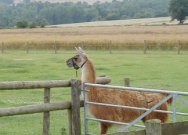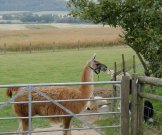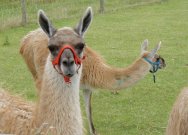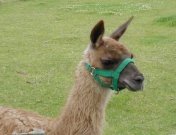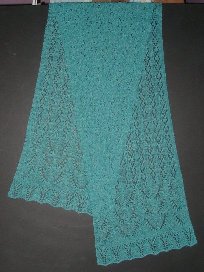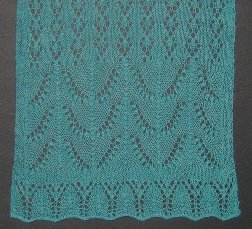Yesterday, we played hookey from packing to visit the guild Dyeing Day, held at a member’s home. Our excuse was that we needed to meet up with some of the others involved in the Roman demo. While we were there, we got cuddly with some of her beautiful guanacos (members of the llama/alpaca family with wonderfully fine spinnable coats, only 18 microns thick).
Unfortunately the camera batteries ran out before they came across to make friends, but here are the best of what we did get. Click on the thumbnails for full-size versions, as usual, and use your browser back button to return here.
First, the boss of the herd .. well he thinks he is, anyway, and the third picture shows him about to spit at the upstart collie who was teasing him from outside the fence.
One of the breeding females. Rys thought she was going to spit at me, but she was actually very friendly.
… and another female …
… but my favourites were the crias (the youngsters). Two were particularly friendly. They cuddled and snuggled and rested their heads on our shoulders, and breathed in our faces (no, not ugh … lovely sweet breath) and tried to suck our T-shirts and … well, they were just adorable.
Unfortunately, one of the friendly crias is a male, and his lack of fear and espect would make him dangerous as an adult male, so he will have ‘the snip’ in a couple more months.
backup, backup, backup …
… and the story of this moral is that my c: drive got corrupted last week and I lost all the data on it, and no, of course I hadn’t been good enough about keeping backups. I think I’m saddest about losing pictures of projects which I gave away or sent to exchanges over the past couple of years. I was better about things like my mail archive. Fortunately, some of the project pictures are here or on my web site, so I can retrieve those.
Anyway, if you have been reading this looking for fibre content, sorry, there isn’t any, except that our guild is involved in 2 Open Days at Silchester, a local Iron Age/Roman archaeological site, demonstrating Roman textile production. We are currently deep in the research stage. This evening, I’m going to inspect the progress in building our warp-weighted loom. I’ll write more about it over the next couple of weeks, or give an URL to the guild page on it when we get that done.
Meanwhile, here is another site about Calleva Atrebatum , as Roman Silchester was known.
Sometimes Tigs likes to hang around the table loom …. usually under it, but occasionally he gets higher ambitions.

A few minutes later, he was back in his usual position …
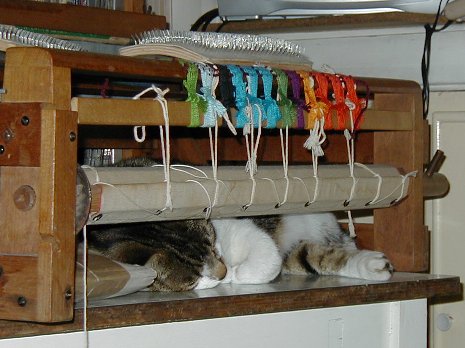
The carders are on top of the cloth to stop him lying there, BTW
Well, quite a lot has been happening since my last blog update, but most of it involves sorting stash before we move out, and that would be a boring blog entry. I’ll just say that I have a LOT of yarn and fibre and fibre-related books, and even though I’ve parted with some, it has hardly made a dent in it. Deciding what I need available over the summer and autumn and what I can take to the storage unit is .. well .. difficult.
However, I have managed to get a little knitting done, and some spinning on my amazing birthday present, a Bosworth book charkha. Rumour has it that there is a birthday spindle on its way too :-). I won’t display my attempts at cotton spinning at this stage (maybe soon), but I’m finidng it a struggle even with such wonderful equipment.
As for the knitting, I’m making slow progress on a pair of boring socks and I’ve just finished and blocked a scarf in purple Jaggerspun Zephyr (wool/silk). It is a standard seaman’s scarf with a stitch pattern taken from the centre of the Fiber Trends’ Estonian Garden pattern (see March archive). I love knitting lace in Zephyr!
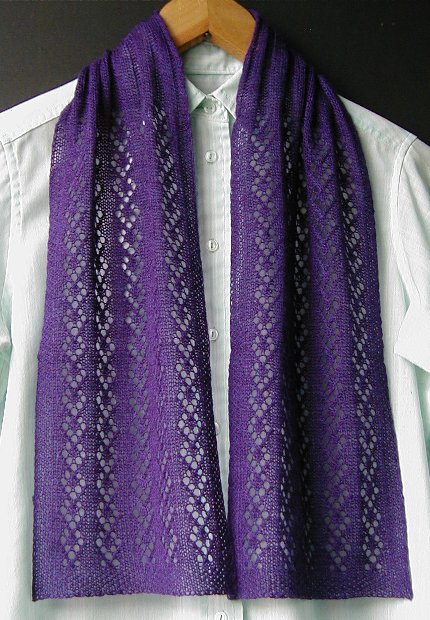
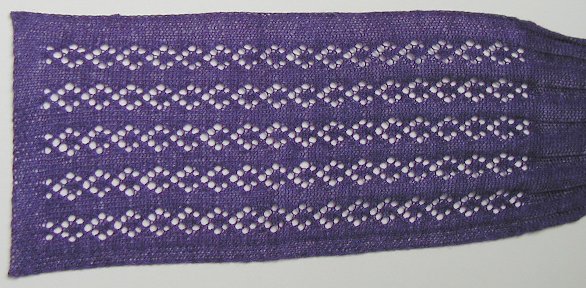
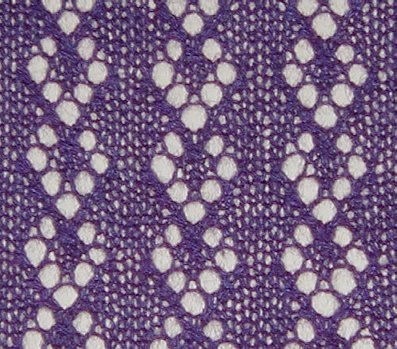
I can’t resist a little bragging. The cushion got 2nd place out of 18 entries … :-)
Tomorrow is the Annual General Meeting of one of my guilds, and also judging day for the annual Challenge. This year, the challenge is to make something with the two largest dimensions between 9″ and 15″ (in other words, the smallest thing you can enter would be a flat object 9″ square and the largest would be a 15″ cube).
I decided quite early on that one of my entries (as it turns out, my only entry) would be a cushion cover, as my other guild has that as its June challenge (a convenient coincidence). I couldn’t decide which technique to use until about a month ago when I saw an article in the then-latest Handwoven (March/April) about a black Tencel-and-metallic eyelash evening jacket (Sara Nordling’s Evening Star Jacket). The structure interested me, so I adapted it for 10/2 nm (metric count, slightly thinner than #5 pearl cotton) unbleached mercerised cotton.
I dyed some of the yarn in two shades of pale brown (which turned out pinkier than intended) to add variety to the warp and for the pattern weft, and wove it on my Louet Kombo table loom as I have another project on my floor loom. I sampled some variations on the structure but ended up with the same one as in the article. I took the fabric off the loom yesterday, washed and dried it, and this morning I sewed the cushion cover. I’m quite pleased with it.
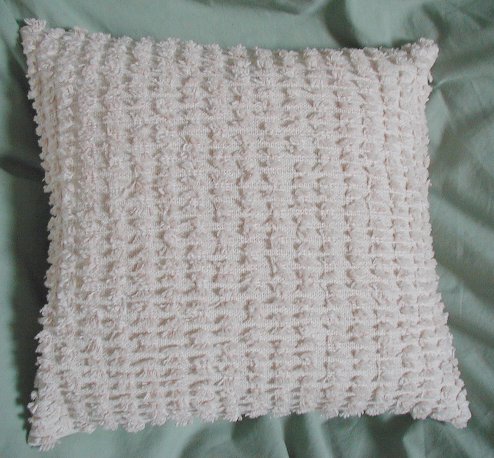
Here is a closeup of the fabric:
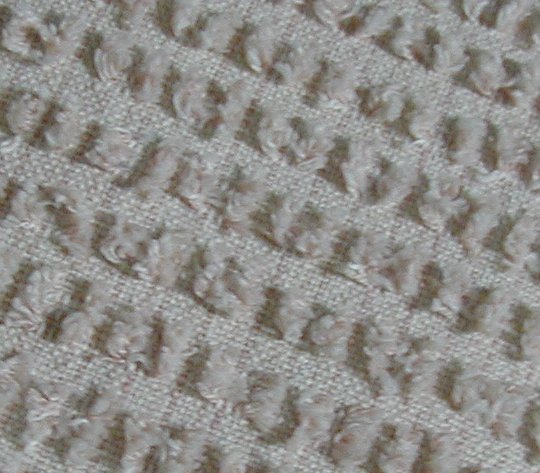
The back is just plain weave, so it shows the warp colour sequence better:
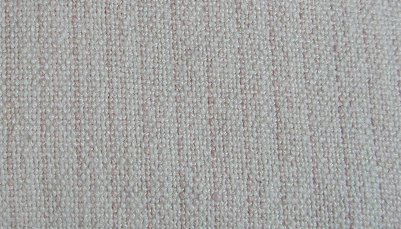
Each year, Kennet Valley Guild holds a skein competition. This year, we were given an ounce of washed mohair locks and asked to combine them with an equal amount of something else and bring the finished skein to the next month’s meeting.
I haven’t had much experience with mohair as I find commercial mohair yarn too scratchy (yes, even kid mohair/silk blends). I considered doing something wild (leaving it as locks and letting the curls hang out of the yarn, or adding in feathers, perhaps), but as usual I left it too late, so I decided play safe.
I blended the mohair with Blue Faced Leicester (my favourite wool breed) on a drumcarder, split the batts into pieces and dyed them separately and then recombined them on the drumcarder, Deb Menz style. The picture top left is the dyed sections. The one below it is after one pass through the carder. I was disappointed with how quickly the colours were blending (I think because there was so little of each colour so the layers were very thin) but I still needed to do another pass to get the batt even enough to spin easily.
I was pleasantly surprised by how it actually spun up. It wasn’t as bright as I’d intended but the combination of the shine of the mohair and the subtle colours reminds me of the splitting of light by a thin oil film on water. No, it didn’t win, but it got enough compliments to make me happy. :-)
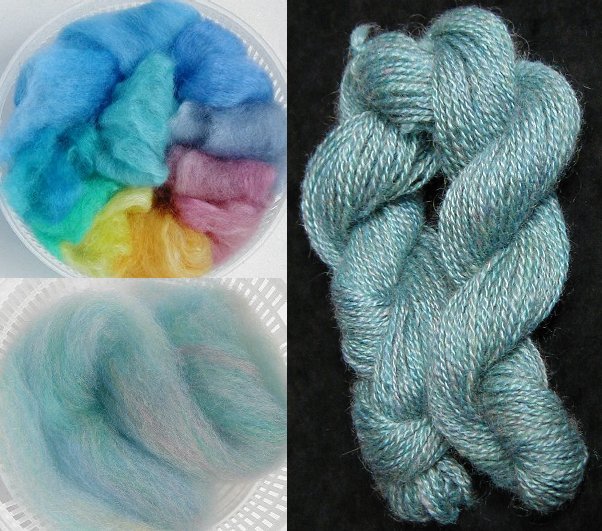
First pictures of the finished Estonian Garden scarf/stole – there may be more to follow. Click on these pictures to see larger versions (close popup between clicks, or the second one will come up in the wrong size window):
A friend of ours is going through a difficult time, so some of us have decided to make her an afghan, contributing an 8″ square each made from undyed handspun yarn. I haven’t felt much like spinning lately, so I went digging through my yarn stash. I had very little undyed handspun, but I found some oatmeal Blue Faced Leicester (one of my favourite breeds – soft and lustrous) that had been spindle-spun at demos soon after I learned to spin. It’s rather uneven, and overtwisted in places, which limited the kind of patterns I wanted to use. I spent a while trawling through Barbara Walker’s Treasuries, but finally decided I’d just do a simple seed stitch ‘square spiral’ on a stocking stitch ground.

This is just a quick entry to show off the finished bag, as I have to get ready to go out soon. To give an idea of scale, it is 3.5″ tall as shown.

I did want to do something more interesting with the ends of the drawstring, but I couldn’t find a suitable bead locally, and my attempt to create a ‘beaded bead’ in tubular peyote using the same beads as I used in the knitting were’t very successful. If I had more time, I’d keep trying with that, but I want to send it off tomorrow, so …
